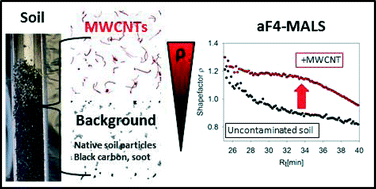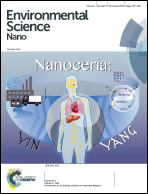Capabilities of asymmetric flow field-flow fractionation coupled to multi-angle light scattering to detect carbon nanotubes in soot and soil†
Abstract
Analytical detection and quantification of multi-walled carbon nanotubes (MWCNTs) in complex matrices such as soils is very challenging. In an initial approach to this task, we identify MWCNTs by making use of their different (e.g., rod-like) shape compared to other (native) soil particles and in particular soot, which is ubiquitously present in soils. A shape factor ρ, determined using asymmetric flow field-flow fractionation coupled to multi-angle light scattering (aF4-MALS), was used to discriminate MWCNTs of different aspect ratios, as well as mixtures of soot and MWCNTs, in pure suspensions. MALS results were additionally confirmed using automated electron microscopy image analysis. We then analyzed different soil types which consistently showed ρ-values that differed from pure MWCNTs. To test the performance of the method for MWCNT detection in such complex matrices, we conducted standard additions of a MWCNT as well as soot to an agricultural soil. Extracts from these MWCNT-spiked soils showed increased ρ-values compared to soot-spiked or native soil. The method detection limit for the MWCNT was 1.6 to 4.0 mg g−1 soil and lies within the range of commonly used black carbon quantification methods, but is much higher than any currently predicted environmental concentration. Additionally, the method is currently limited by a relatively narrow dynamic range of ρ. Despite these limitations, our results suggest that aF4-MALS provides specific shape information that may be linked to an actual MWCNT presence in soils. Further method improvement potential is outlined along different steps of the workflow.


 Please wait while we load your content...
Please wait while we load your content...